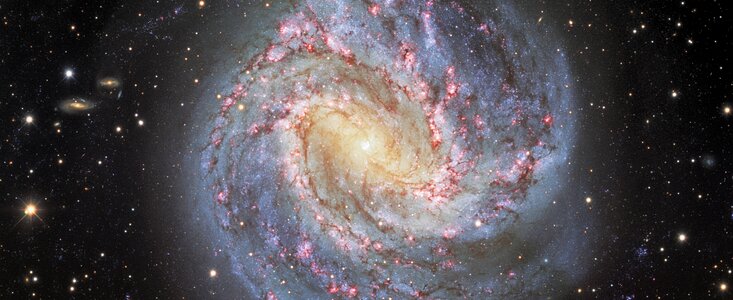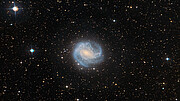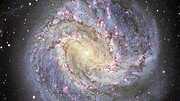The Spiral of the Southern Pinwheel
A camera designed to reveal the deepest secrets of our Universe captures the Southern Pinwheel galaxy in glorious detail
8 February 2021
The Dark Energy Camera (DECam), which was originally designed for the Dark Energy Survey, has captured one of the deepest images ever taken of Messier 83, a spiral galaxy playfully known as the Southern Pinwheel. Built by the US Department of Energy, DECam is mounted on the Víctor M. Blanco 4-meter Telescope at the Cerro Tololo Inter-American Observatory (CTIO), a Program of NSF NOIRLab.
Astronomy enthusiasts might wonder why a camera called the Dark Energy Camera (DECam) would be used to image a single spiral galaxy. DECam has in fact already finished its main job, as the instrument was used to complete the Dark Energy Survey, which ran from 2013 to 2019. Like many people, rather than enjoying a quiet retirement, DECam is remaining occupied. Members of the astronomical community can apply for time to use it, and the data collected are processed and made publicly available [1], thanks to the Astro Data Archive at the Community Science and Data Center (CSDC) Program at NSF’s NOIRLab. DECam’s continued operation also makes sumptuously detailed images like this one possible.
Messier 83, or the Southern Pinwheel, is located in the southern constellation of Hydra and is an obvious target for a beautiful astronomical image. It is oriented so that it is almost entirely face-on as seen from Earth, meaning that we can observe its spiral structure in fantastic detail. The galaxy lies around 15 million light-years away, which makes it a neighbor in astronomical terms. It has a diameter of around 50,000 light-years, so it is a little diminutive in comparison to our own Milky Way, which has a diameter of 100,000–200,000 light-years. In other ways, however, the Southern Pinwheel probably gives a good approximation of how our Milky Way would look to a distant alien civilization.
Six different filters were used on DECam in order to create this spectacular new view of a classical beauty. Filters allow astronomers to select which wavelengths of light they wish to view the sky in. This is crucial for science observations, when astronomers require very specific information about an object, but it also allows colorful images like this one to be created. Observing celestial objects — such as the Southern Pinwheel — with several different filters means that different details can be picked out. For example, the dark tendrils curling through the galaxy are actually lanes of dust, blocking out light. In contrast, the clustered, bright red spots are caused by glowing, hot hydrogen gas (which identifies these as hubs of star formation). Dusty trails and dynamic ionized gas have different temperatures, and are therefore visible in different wavelengths. Filters allow both to be observed separately, and then combined into one intricate image. In all, 163 DECam exposures, with a total combined exposure time of over 11.3 hours, went into creating this portrait of Messier 83.
Yet these observations were not just about creating a pretty picture. They are helping to prepare for upcoming observations by Vera C. Rubin Observatory, a future program of NOIRLab. In ten years of operation, starting in 2023, Rubin Observatory will carry out an unprecedented optical survey of the visible sky named the Legacy Survey of Space and Time (LSST). “The Messier 83 observations are part of an ongoing program to produce an atlas of time-varying phenomena in nearby southern galaxies in preparation for Rubin Observatory’s Legacy Survey of Space and Time,” said Monika Soraisam of the University of Illinois, who is the principal investigator for DECam’s observations of Messier 83. “We are generating multi-color light curves of stars in this galaxy, which will be used to tame the onslaught of alerts expected from LSST using state-of-the-art software infrastructure such as NOIRLab's own ANTARES alert-broker.” [2]
Built by the US Department of Energy (DOE), DECam is mounted on the Víctor M. Blanco 4-meter Telescope at CTIO in Chile. DECam is a powerful instrument that uses 74 highly sensitive charge-coupled devices (CCDs) to take images. CCDs are the same devices that are used to take photos in everyday cell phones. Of course, the CCDs in DECam are much larger, and they were specifically designed to collect very faint red light from distant galaxies. This capability was crucial for DECam’s original purpose, the Dark Energy Survey. This ambitious survey probed one of the most fundamental questions of the Universe — why is our Universe not only expanding, but expanding at an accelerating rate? For six years DECam surveyed the skies, imaging the most distant galaxies to collect more data to enable astronomers to further investigate our accelerating Universe. Taking beautiful images such as this one must seem a lot simpler for DECam.
“While DECam has fulfilled its original goal to complete the Dark Energy Survey, it continues to be a valuable resource for the astronomical community, capturing sweeping views of objects like Messier 83 that both delight the senses and advance our understanding of the Universe,” said Chris Davis, Program Director for NOIRLab at the National Science Foundation.
Notes
[1] Data from DECam typically have an 18-month proprietary period to allow the principal investigators who requested the observations time to perform their research before the data are released publicly for anyone to use.
[2] ANTARES is a software tool built at NOIRLab to process information about changing objects in the night sky and to help distribute that information to the astronomical community.
More information
NSF NOIRLab (National Optical-Infrared Astronomy Research Laboratory), the US center for ground-based optical-infrared astronomy, operates the international Gemini Observatory (a facility of NSF, NRC–Canada, ANID–Chile, MCTIC–Brazil, MINCyT–Argentina, and KASI–Republic of Korea), Kitt Peak National Observatory (KPNO), Cerro Tololo Inter-American Observatory (CTIO), the Community Science and Data Center (CSDC), and Vera C. Rubin Observatory (in cooperation with DOE’s SLAC National Accelerator Laboratory). It is managed by the Association of Universities for Research in Astronomy (AURA) under a cooperative agreement with NSF and is headquartered in Tucson, Arizona. The astronomical community is honored to have the opportunity to conduct astronomical research on Iolkam Du’ag (Kitt Peak) in Arizona, on Maunakea in Hawai‘i, and on Cerro Tololo and Cerro Pachón in Chile. We recognize and acknowledge the very significant cultural role and reverence that these sites have to the Tohono O'odham Nation, to the Native Hawaiian community, and to the local communities in Chile, respectively.
Contacts
Amanda Kocz
Press and Internal Communications Officer
NSF NOIRLab
Cell: +1 520 318 8591
Email: amanda.kocz@noirlab.edu
About the Release
| Release No.: | noirlab2107 |
| Name: | M83 |
| Facility: | Víctor M. Blanco 4-meter Telescope |
| Instruments: | DECam |







